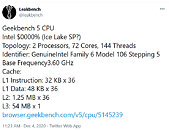Monday, December 7th 2020

Intel Ice Lake-SP Processor Spotted with 36 Cores and 3.6 GHz Base Clock
Today, in the latest GeekBench 5 submission by ASUS, we have discovered something rather interesting. Intel's Ice Lake-SP processors were rumored to arrive with up to 28 cores and 56 threads at maximum, on a single chip. That was due to the 10 nm process used to make these chips, with suspicions that the yield of the node was not good enough to make any higher core count parts. Thanks to the GB5 listing, discovered by Leakbench on Twitter, the Intel Ice Lake-SP CPU engineering sample appeared with an amazing 36 cores with 72 threads. This is supposedly Intel's efforts to try and match the 64 cores and 128 threads of AMD's EPYC "Rome" CPUs, which are winning many server applications due to their performance.
The 36C/72T chip was paired with another similar chip in a 2P dual-socket configuration, which made the total core count rise to 72 cores and 144 threads, running inside of Asustek's Y4R-A1-ASUS-G1 server. The system was reporting a clock frequency of 3.6 GHz base speed, which means that the possible boost clocks could be higher. The CPU features a 1.25 MB level two (L2) cache per core (45 MB in total) and 54 MB of unified level three (L3) cache. That makes this CPU core quite an improvement over the past Cooper Lake generation. We are waiting for more information about these CPUs, and we are going to report on it in the coming time.
Source:
Leakbench (Twitter)
The 36C/72T chip was paired with another similar chip in a 2P dual-socket configuration, which made the total core count rise to 72 cores and 144 threads, running inside of Asustek's Y4R-A1-ASUS-G1 server. The system was reporting a clock frequency of 3.6 GHz base speed, which means that the possible boost clocks could be higher. The CPU features a 1.25 MB level two (L2) cache per core (45 MB in total) and 54 MB of unified level three (L3) cache. That makes this CPU core quite an improvement over the past Cooper Lake generation. We are waiting for more information about these CPUs, and we are going to report on it in the coming time.


17 Comments on Intel Ice Lake-SP Processor Spotted with 36 Cores and 3.6 GHz Base Clock
Whether they can make these or not is a bit irrelevant as smaller dies should be more cost effective in any case, especially on a cutting edge node.
Running at 2.2GHz, no boost.
This is either an ES or a bust.
It's not competitive against AMD's lower cost chiplet designs but it's purpose is really just to slow adoption of AMD products until Intel is in a position to launch something more competitive.
Servers are built for a specific purpose in mind. Cinebench and Geekbench scores or average benchmark scores are completely irrelevant. The most important factor is the performance in the specific task the server will be running, along with various other constraints. So a 36 core Xeon could be superior in some workloads compared to a 64 core Epyc, and the completely opposite in others.
And lastly, the pricing of server parts is very fluid, so don't emphasize list price too much.
I agree that Intel has some performance advantages but the AMD production cost advantage is significant.